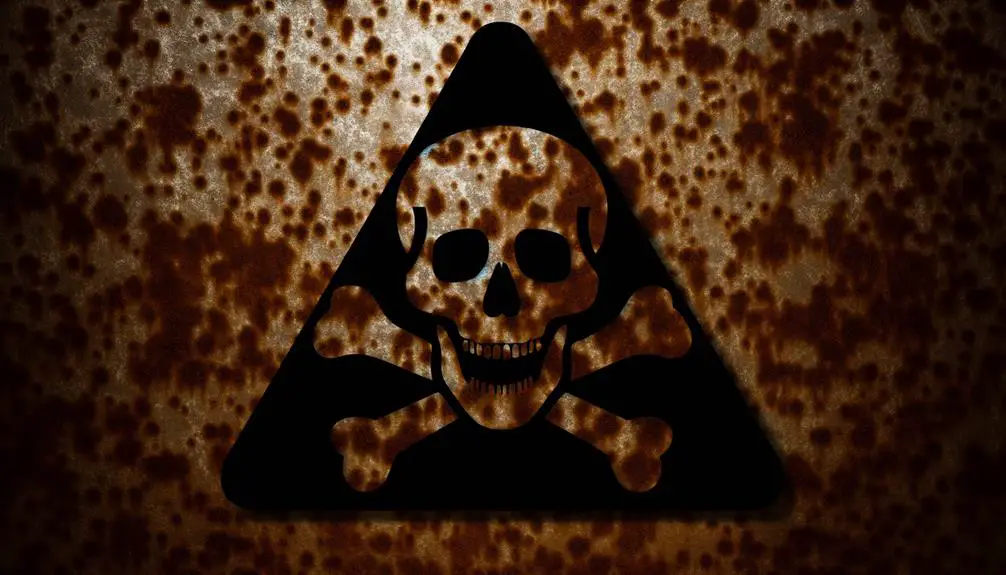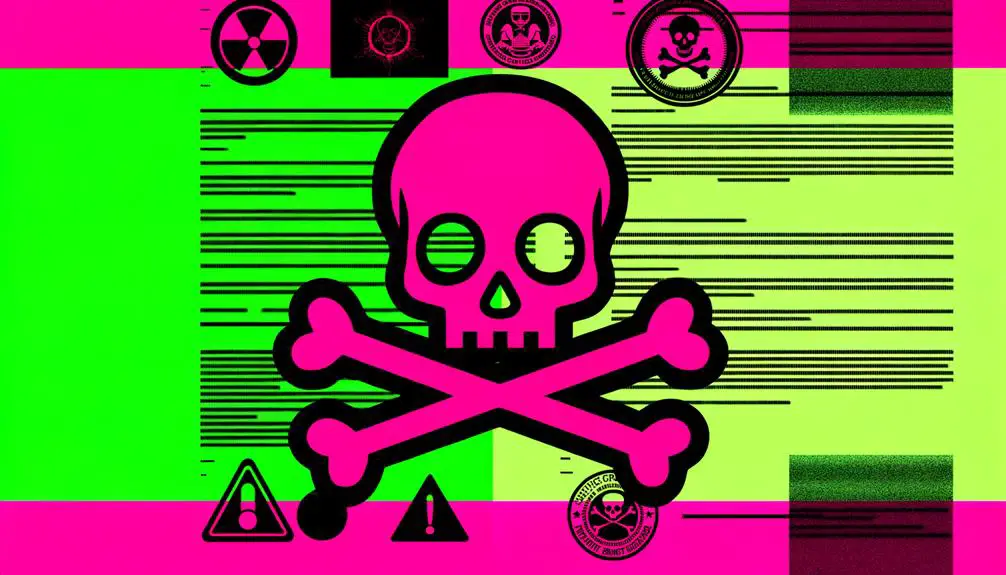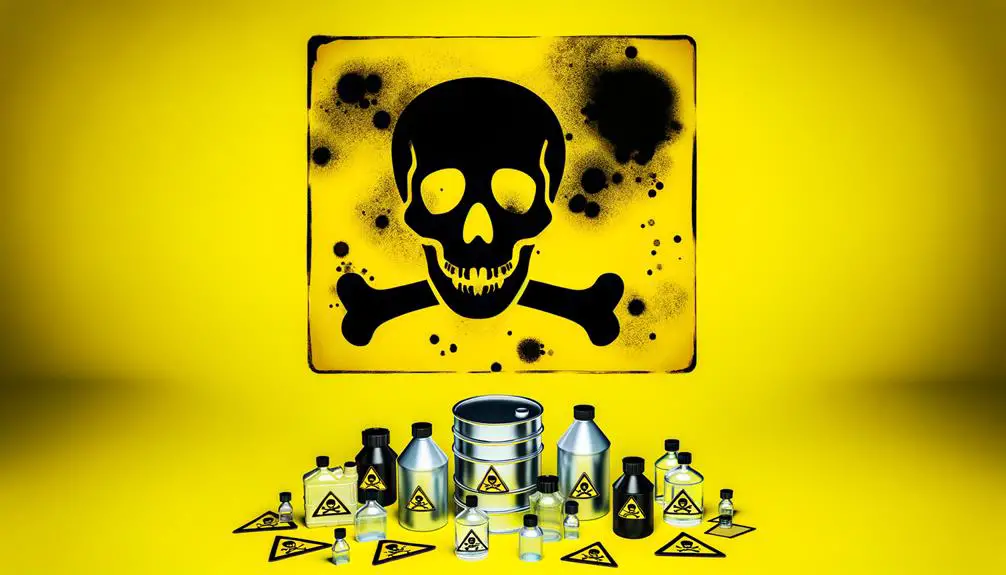Skull and Crossbones Hazard Symbol: What Is Its Meaning?
The Skull and Crossbones hazard symbol serves as a critical warning of the presence of toxic substances. Originating from the 18th-century pirate flags, the symbol is now universally used to denote imminent danger and severe health risks.
It is essential in regulatory compliance, ensuring rapid recognition of poisons in industrial safety contexts and household items. This symbol prompts necessary safety measures such as appropriate labeling, usage of personal protective equipment (PPE), and adherence to proper storage protocols.
Understanding its historical context and varied applications can provide deeper insights into its significance and efficacy in hazard communication.

Key Takeaways
- The skull and crossbones symbol is a universal warning of imminent danger.
- It indicates the presence of toxic or poisonous substances.
- The symbol alerts to severe health risks associated with hazardous materials.
- It is prominently displayed to facilitate rapid recognition and appropriate response.
- The symbol has historical origins in piracy and alchemy, symbolizing danger across different eras.
Historical Origins

The skull and crossbones symbol, historically rooted in pirate imagery, dates back to the early 18th century when it was first used on pirate flags to signify danger and death. This iconography, known as the 'Jolly Roger,' served to instill fear and prompt immediate surrender from targeted ships.
Originating during the Golden Age of Piracy (circa 1716-1726), the symbol was adopted by various notorious pirates, including Blackbeard and Calico Jack. Its design typically features a human skull above two crossed femurs, evoking a stark warning.
Beyond maritime contexts, the skull and crossbones began appearing in military and chemical hazard contexts by the mid-19th century, evolving into a universal emblem for lethal danger across different domains.
Symbol Significance
The skull and crossbones symbol functions as a universal warning of imminent danger, particularly indicating the presence of toxic substances. Its significance is rooted in historical contexts where it has been employed to signal lethal hazards.
Understanding its adoption and application can provide vital insights into its enduring efficacy in hazard communication.
Universal Danger Warning
Representing a universally acknowledged signal for danger, the skull and crossbones symbol serves as a critical warning indicator for toxic substances and hazardous conditions. This emblem transcends language barriers, guaranteeing that individuals from diverse backgrounds comprehend its significance. The symbol's efficacy lies in its clear and immediate conveyance of peril, prompting cautionary measures.
Its applications span various contexts:
- Industrial Safety: Alerts workers to the presence of hazardous chemicals.
- Consumer Products: Indicates poisonous household items.
- Environmental Hazards: Marks contaminated areas necessitating protective measures.
- Regulatory Compliance: Secures adherence to safety standards internationally.
Toxic Substance Indicator
In addition to its role as a universal danger warning, the skull and crossbones symbol specifically signifies the presence of toxic substances, demanding immediate precautionary actions. This icon serves as a critical indicator in various industries, including chemical manufacturing, pharmaceuticals, and hazardous waste management.
It alerts personnel to the potential for severe health risks such as poisoning, organ damage, or even death upon exposure. The symbol's use is governed by stringent regulatory standards, ensuring consistent identification and handling of toxic materials.
Its prominent display on labels and safety data sheets (SDS) facilitates rapid recognition and appropriate response protocols, thereby mitigating risks associated with inadvertent exposure or mishandling of hazardous substances.
Historical Symbol Origins
Although its modern usage is closely associated with toxic substances, the skull and crossbones symbol has historical roots that trace back to piracy and medieval alchemy. In these contexts, the symbol carried varied yet significant connotations:
- Piracy: Pirates used the symbol on their flags to instill fear and signal impending danger, often associated with death.
- Alchemy: Alchemists marked substances with the symbol to denote poisons or lethal compounds.
- Military: Historical military units utilized the symbol to represent mortality and the inevitability of death in battle.
- Grave Markers: The symbol appeared on gravestones to remind viewers of mortality and the transient nature of life.
This historical context enriches our understanding of the skull and crossbones as a multifaceted emblem of danger across different eras.
Regulatory Guidelines

Regulatory guidelines for the skull and crossbones hazard symbol are governed by global safety standards to maintain consistency in hazard communication.
Compliance with labeling requirements is vital to prevent misidentification and guarantee worker safety.
Specific industries may have additional regulations, necessitating tailored implementation to address unique hazards.
Global Safety Standards
Adherence to global safety standards is critical for guaranteeing the consistent and accurate application of the skull and crossbones hazard symbol across various industries. These standards, governed by regulatory bodies such as OSHA, GHS, and ISO, provide a framework to mitigate risks associated with toxic substances.
Key global standards include:
- GHS (Globally Harmonized System): Standardizes hazard communication worldwide.
- OSHA (Occupational Safety and Health Administration): Guarantees workplace safety in the United States.
- REACH (Registration, Evaluation, Authorization, and Restriction of Chemicals): Regulates chemical safety within the European Union.
- ISO 7010: Specifies safety signs and symbols for global consistency.
Labeling Compliance Essentials
Securing proper labeling compliance demands a thorough understanding of the regulatory guidelines set forth by authorities like OSHA, GHS, and ISO. These frameworks dictate essential elements for hazard communication, securing that labels are consistent, accurate, and visible. Compliance involves precise labeling of hazardous chemicals with the Skull and Crossbones symbol, indicating acute toxicity. Below is a concise table summarizing key regulatory guidelines:
| Authority | Key Focus | Requirements |
|---|---|---|
| OSHA | Worker Safety | Clear hazard communication |
| GHS | Global Harmony | Standardized symbols and warnings |
| ISO | Quality | Consistent and internationally recognized labels |
Adhering to these guidelines not only secures legal compliance but also enhances workplace safety by effectively communicating potential hazards.
Industry-Specific Requirements
Different industries face unique regulatory requirements when it comes to hazard labeling, necessitating tailored approaches to comply with sector-specific safety standards. Regulatory bodies impose distinct guidelines based on the potential risks and operational contexts of each sector. For instance, chemical manufacturing must adhere to the Globally Harmonized System (GHS) standards, while the pharmaceutical sector follows stringent FDA regulations.
Key industry-specific requirements include:
- Chemical Manufacturing: Compliance with GHS for classification and labeling.
- Pharmaceuticals: Adherence to FDA regulations for hazardous substances.
- Agriculture: Conformance to EPA guidelines for pesticide labeling.
- Construction: OSHA standards for workplace hazardous materials.
These industry-specific guidelines guarantee that the Skull and Crossbones symbol is used accurately, facilitating effective risk communication and enhancing safety measures across varied operational environments.
Industry Applications
The skull and crossbones hazard symbol is extensively utilized across various industries to denote substances that pose significant toxicological risks. Its application is critical for ensuring compliance with safety regulations and protecting human health. Industries such as pharmaceuticals, agriculture, and manufacturing rely on this symbol to communicate the presence of toxic chemicals effectively.
| Industry | Common Applications |
|---|---|
| Pharmaceuticals | Labeling potent drugs and compounds |
| Agriculture | Marking pesticides and herbicides |
| Manufacturing | Identifying hazardous raw materials |
The symbol aids in risk assessment, guiding proper handling, storage, and disposal practices. Effective use of this hazard symbol minimizes accidental exposure and potential health hazards, thereby maintaining workplace safety and regulatory adherence.
Identifying Hazardous Substances

Identifying hazardous substances involves a systematic approach to recognizing chemicals that present toxicological risks, as indicated by the skull and crossbones hazard symbol. This process requires a thorough understanding of chemical properties and potential health impacts.
Key steps in identification include:
- Chemical Composition Analysis: Examining the molecular structure and chemical components.
- Toxicological Data Review: Evaluating information from toxicology studies, including lethal doses (LD50).
- Regulatory Classification: Consulting regulatory databases such as GHS (Globally Harmonized System) for classification.
- Label and Documentation Inspection: Reviewing Safety Data Sheets (SDS) and labeling for hazard communication.
This methodical approach guarantees accurate identification, enabling appropriate management of risks associated with hazardous substances. Understanding these elements is essential for maintaining safety and compliance in various settings.
Safety Precautions
Implementing safety precautions is essential to mitigate the risks associated with hazardous substances indicated by the skull and crossbones symbol.
First, guarantee proper labeling and storage of these substances in designated, secure areas to prevent accidental exposure. Use appropriate personal protective equipment (PPE), such as gloves, goggles, and respiratory protection, based on the specific chemical hazards.
Employ engineering controls, including fume hoods and ventilation systems, to minimize inhalation risks. Conduct regular training sessions for employees to ensure they are knowledgeable about handling procedures and emergency response protocols.
Additionally, maintain Material Safety Data Sheets (MSDS) accessible to all personnel for reference. Implementing these measures will significantly decrease the potential for adverse health effects and environmental contamination.
Conclusion
The skull and crossbones hazard symbol, with its historical origins and significant regulatory guidelines, serves as a critical indicator of toxic substances in various industries. The symbol's application in identifying hazardous materials guarantees safety through standardized precautions.
Some may argue that modern symbols could be more effective; however, the widespread recognition and longstanding use of the skull and crossbones make it an indispensable tool in hazard communication, facilitating immediate and universal understanding of toxic risks.






